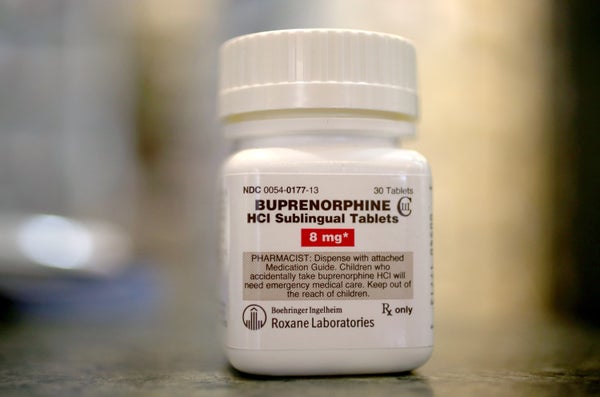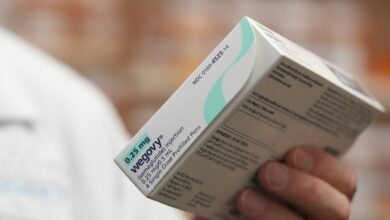
December 10, 2024
5 min read
Addiction Telemedicine Has Saved Lives. Let’s Keep It Going
Pandemic relaxation of buprenorphine-prescribing restrictions must continue to keep saving lives amid a U.S. overdose epidemic

Buprenorphine, seen here in a pharmacy, is prescribed to help addicts recovering from opioid use disorder.
Addiction medicine came unlocked in the COVID era, a small silver lining amid declining, but still staggering, numbers of U.S. overdose deaths. As the pandemic recedes in the public memory, keeping the benefits of these changes matters if we want to keep saving lives.
In November the federal Drug Enforcement Administration (DEA) extended a rule allowing prescription of the drug buprenorphine for opioid use disorder without an initial in-person evaluation. This telemedicine-permitting extension only lasts until the end of December 2025. While this is a positive step, this rule and ones like it must be made permanent.
In the aftermath of the pandemic, and with such changes, U.S. overdose deaths have fallen to fewer than 100,000 annually. “Cementing these policies is a step in the right direction in the fight against the worsening overdose epidemic to increase equitable access to care, reduce stigma of seeking treatment for opioid use disorder and embrace technology in medicine,” says Bobby Mukkamala, the chair of the American Medical Association’s (AMA) Substance Use and Pain Care Task Force and member of the AMA Board of Trustees, echoing many addiction experts. To do otherwise will lead to needless death for no legitimate reason. The Trump administration and Congress can play a vital role in 2025 in further reducing overdose deaths, by taking the critical step to highlight this issue for immediate consideration and action.
On supporting science journalism
If you’re enjoying this article, consider supporting our award-winning journalism by subscribing. By purchasing a subscription you are helping to ensure the future of impactful stories about the discoveries and ideas shaping our world today.
Buprenorphine is one of three FDA-approved opioid-use disorder medications to treat opioid use disorder. Buprenorphine is a controlled substance, and any practitioner looking to offer it must be registered with the DEA. Prior to the December 2022 elimination of an “X-waiver” requirement, buprenorphine prescribers also needed an additional DEA authorization.
As part of the COVID public health emergency, the federal government allowed practitioners to prescribe buprenorphine without the need for an in-person visit and after conducting an initial telemedicine visit, using either audio-visual or telephonic connection. The DEA held two days of public listening sessions in 2023 and received testimony from leading experts in the field, as well as more than 38,000 comments; it was in light of that feedback that the DEA and Department of Health and Human Services (HHS) extended current telemedicine flexibility until its current December 2025 limit.
There is significant evidence that the impact of this rule has increased access to this lifesaving medicine, overcoming barriers to people starting treatment, which we know reduces overdoses.
Nevertheless there has been an ongoing effort in Washington, led by the DEA, to limit medical professionals’ treating opioid use disorder with this life saving medicine. The first effort occurred in 2023 when the DEA proposed a rule that would have required that any patient who had been started on buprenorphine through a telemedicine visit be seen in person by the prescriber within 30 days before any new prescription could be issued. This proposed rule received thousands of negative comments, and ultimately the current rule was adopted.
Subsequently, the DEA held forums requesting input on whether a permanent rule should include a “special registry,” where prescribers would need to register with the DEA to use telemedicine to offer buprenorphine to their patients.
Finally, the DEA put forward a proposed rule in mid-2024, which my time in the White House Office of National Drug Control Policy suggests most likely included a registry or the need for an in-person visit (this proposal was never made public). That proposed rule was rejected within the internal approval process used by the Biden administration. The current rule was then extended yet again.
The DEA’s proclivity for restricting access to buprenorphine is also part of its institutionalized efforts to prevent “diversion” of controlled substances, the illegal sales of either licit or illicit drugs. The flaw in the DEA’s approach centers on the agency never providing any evidence that buprenorphine is being diverted because of the telemedicine rule. Or any other circumstance, for that matter. In fact, studies have shown that prevalence of buprenorphine misuse has decreased since the new rule took effect.
Given the evidence that buprenorphine misuse has trended downward with the new rule, providers must not be forced under the new administration to overcome additional barriers to prescribing lifesaving medication to their opioid dependent patients. Buprenorphine is less likely to cause overdoses than other opioids because its effects taper off at higher doses.
With change coming in U.S. political leadership, it is imperative that the facts, not drug war dogma, guide the new rule beyond 2025. Complicating this decision, policy makers have historically created a growing web of legal restrictions on controlled substances under the false premise that this will reduce drug-related deaths. The science is clear: these efforts do not reduce deaths and may, in fact, lead to more.
If the coming Trump administration cannot find its way to making the current rule permanent, then Congress should consider taking such an action. Another possibility would be for the new administration to extend the current rule until the end of the national opioid public health emergency, which was put in place by president Donald Trump during his first term in 2017.
Before creating any “special registry,” the DEA should tell us how much buprenorphine is being diverted, and how much is diverted from prescriptions for pain, rather than the treatment of opioid use disorder? The answers will tell us if we have a real problem or if the “special registry” is a solution in search of one.
It’s not like the government lacks authority. Prescribers of buprenorphine are already subject to DEA oversight by virtue of needing an agency registration to prescribe any controlled substance. Further, they are subject to additional state oversight as they must hold a professional state license to prescribe medications. And they have additional obligations to prevent prescription abuse through their state’s prescription drug monitoring program.
Saving lives demands actions that show a real understanding of the problem. Otherwise, we’ll only get more overdoses and more deaths.
We have nearly three years of evidence showing the benefits of buprenorphine prescribing without the need for an in-person visit. Nothing shows that there has been an increase in diversion, or an increase in drug related deaths caused by easier access to buprenorphine. The evidence is quite to the contrary. The new administration must further reduce overdose deaths, by taking the critical step of continuing access to this lifesaving medicine.
This is an opinion and analysis article, and the views expressed by the author or authors are not necessarily those of Scientific American.
Source link







